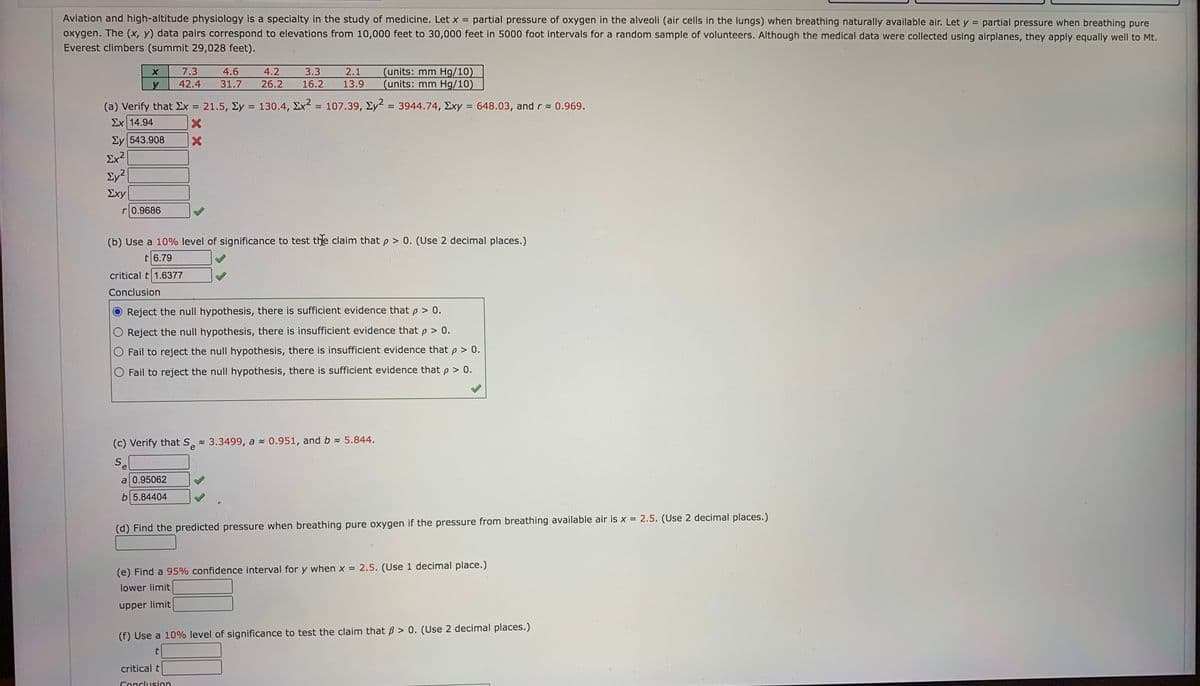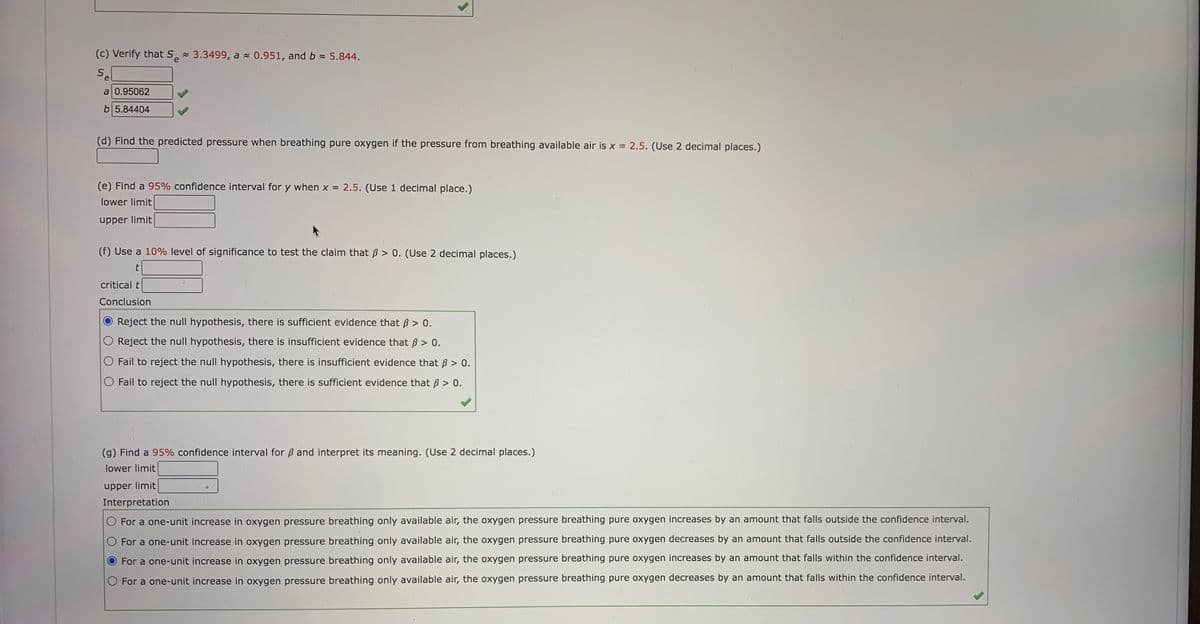Aviation and high-altitude physiology is a specialty in the study of medicine. Let x partial pressure of oxygen in the alveoli (air cells in the lungs) when breathing naturally available air. Let y = partial pressure when breathing pure oxygen. The (x, y) data pairs correspond to elevations from 10,000 feet to 30,000 feet in 5000 foot intervals for a random sample of volunteers. Although the medical data were collected using airplanes, they apply equally well to Mt. Everest climbers (summit 29,028 feet). X 7.3 Ly 42.4 (units: mm Hg/10) (units: mm Hg/10) 4.6 4.2 3.3 2.1 31.7 26.2 16.2 13.9 (a) Verify that Ex = 21.5, Ey = 130.4, Ex = 107.39, Ey? = 3944.74, Exy = 648.03, and r= 0.969. %3D Ex 14.94 Ey 543.908 Ey2 Exy r0.9686 (b) Use a 109% level of significance to test the claim that p> 0. (Use 2 decimal places.) t6.79 critical t 1.6377 Conclusion Reject the null hypothesis, there is sufficient evidence that p> 0. O Reject the null hypothesis, there is insufficient evidence that p> 0. O Fail to reject the null hypothesis, there is insufficient evidence thatp> 0. O Fail to reject the null hypothesis, there is sufficient evidence that p> 0. (c) Verify that S 3.3499, a- 0.951, and b 5.844. e a 0.95062 b 5.84404 (d) Find the predicted pressure when breathing pure oxygen if the pressure from breathing available air is x= 2.5. (Use 2 decimal places.) (e) Find a 95% confidence interval for y when x = 2.5. (Use 1 decimal place.) lower limit upper limit (1) Use a 10% level of significance to test the claim that > 0. (Use 2 decimal places.) critical t
Aviation and high-altitude physiology is a specialty in the study of medicine. Let x partial pressure of oxygen in the alveoli (air cells in the lungs) when breathing naturally available air. Let y = partial pressure when breathing pure oxygen. The (x, y) data pairs correspond to elevations from 10,000 feet to 30,000 feet in 5000 foot intervals for a random sample of volunteers. Although the medical data were collected using airplanes, they apply equally well to Mt. Everest climbers (summit 29,028 feet). X 7.3 Ly 42.4 (units: mm Hg/10) (units: mm Hg/10) 4.6 4.2 3.3 2.1 31.7 26.2 16.2 13.9 (a) Verify that Ex = 21.5, Ey = 130.4, Ex = 107.39, Ey? = 3944.74, Exy = 648.03, and r= 0.969. %3D Ex 14.94 Ey 543.908 Ey2 Exy r0.9686 (b) Use a 109% level of significance to test the claim that p> 0. (Use 2 decimal places.) t6.79 critical t 1.6377 Conclusion Reject the null hypothesis, there is sufficient evidence that p> 0. O Reject the null hypothesis, there is insufficient evidence that p> 0. O Fail to reject the null hypothesis, there is insufficient evidence thatp> 0. O Fail to reject the null hypothesis, there is sufficient evidence that p> 0. (c) Verify that S 3.3499, a- 0.951, and b 5.844. e a 0.95062 b 5.84404 (d) Find the predicted pressure when breathing pure oxygen if the pressure from breathing available air is x= 2.5. (Use 2 decimal places.) (e) Find a 95% confidence interval for y when x = 2.5. (Use 1 decimal place.) lower limit upper limit (1) Use a 10% level of significance to test the claim that > 0. (Use 2 decimal places.) critical t
Algebra & Trigonometry with Analytic Geometry
13th Edition
ISBN:9781133382119
Author:Swokowski
Publisher:Swokowski
Chapter7: Analytic Trigonometry
Section7.6: The Inverse Trigonometric Functions
Problem 92E
Related questions
Question

Transcribed Image Text:Aviation and high-altitude physiology is a specialty in the study of medicine. Let x =
oxygen. The (x, y) data pairs correspond to elevations from 10,000 feet to 30,000 feet in 5000 foot intervals for a random sample of volunteers. Although the medical data were collected using airplanes, they apply equally well to Mt.
Everest climbers (summit 29,028 feet).
partial pressure of oxygen in the alveoli (air cells in the lungs) when breathing naturally available air. Let y = partial pressure when breathing pure
(units: mm Hg/10)
(units: mm Hg/10)
7.3
4.6
4.2
3.3
2.1
42.4
31.7
26.2
16.2
13.9
(a) Verify that Ex
21.5, Σy = 130.4, Σx
107.39, Ey = 3944.74, Exy = 648.03, and r 0.969.
%3D
%3D
%3D
Ex 14.94
Ey 543.908
Ex2
Ey2
Σχy
0.9686
(b) Use a 10% level of significance to test the claim that p > 0. (Use 2 decimal places.)
t 6.79
critical t 1.6377
Conclusion
Reject the null hypothesis, there is sufficient evidence that p > 0.
O Reject the null hypothesis, there is insufficient evidence that p > 0.
O Fail to reject the null hypothesis, there is insufficient evidence that p > 0.
Fail to reject the null hypothesis, there is sufficient evidence that p > 0.
(c) Verify that S, 3.3499, a 0.951, and b 5.844.
Se
a 0.95062
b 5.84404
(d) Find the predicted pressure when breathing pure oxygen if the pressure from breathing available air is x = 2.5. (Use 2 decimal places.)
2.5. (Use 1 decimal place.)
(e) Find a 95% confidence interval for y when x =
lower limit
upper limit
(f) Use a 10% level of significance to test the claim that B > 0. (Use 2 decimal places.)
critical t
Conclusion

Transcribed Image Text:(c) Verify that S 3.3499, a 0.951, and b 5.844.
e
Se
a 0.95062
b 5.84404
(d) Find the predicted pressure when breathing pure oxygen if the pressure from breathing available air is x = 2.5. (Use 2 decimal places.)
%3D
(e) Find a 95% confidence interval for y when x = 2.5. (Use 1 decimal place.)
lower limit
upper limit
(f) Use a 10% level of significance to test the claim that B > 0. (Use 2 decimal places.)
critical t
Conclusion
Reject the null hypothesis, there is sufficient evidence that Bß > 0.
Reject the null hypothesis, there is insufficient evidence that ß > 0.
O Fail to reject the null hypothesis, there is insufficient evidence that ß > 0.
O Fail to reject the null hypo
esis, there is sufficient evidence that B > 0.
(g) Find a 95% confidence interval for ß and interpret its meaning. (Use 2 decimal places.)
lower limit
upper limit
Interpretation
For a one-unit increase in oxygen pressure breathing only available air, the oxygen pressure breathing pure oxygen increases by an amount that falls outside the confidence interval.
O For a one-unit increase in oxygen pressure breathing only available air, the oxygen pressure breathing pure oxygen decreases by an amount that falls outside the confidence interval.
For a one-unit increase in oxygen pressure breathing only available air, the oxygen pressure breathing pure oxygen increases by an amount that falls within the confidence interval.
For a one-unit increase in oxygen pressure breathing only available air, the oxygen pressure breathing pure oxygen decreases by an amount that falls within the confidence interval.
Expert Solution
This question has been solved!
Explore an expertly crafted, step-by-step solution for a thorough understanding of key concepts.
Step by step
Solved in 5 steps

Recommended textbooks for you

Algebra & Trigonometry with Analytic Geometry
Algebra
ISBN:
9781133382119
Author:
Swokowski
Publisher:
Cengage

Functions and Change: A Modeling Approach to Coll…
Algebra
ISBN:
9781337111348
Author:
Bruce Crauder, Benny Evans, Alan Noell
Publisher:
Cengage Learning

Algebra & Trigonometry with Analytic Geometry
Algebra
ISBN:
9781133382119
Author:
Swokowski
Publisher:
Cengage

Functions and Change: A Modeling Approach to Coll…
Algebra
ISBN:
9781337111348
Author:
Bruce Crauder, Benny Evans, Alan Noell
Publisher:
Cengage Learning